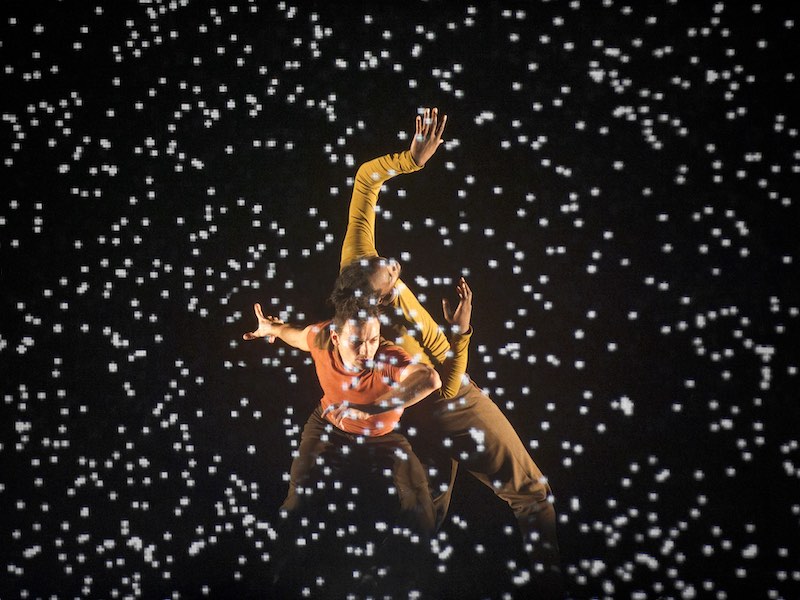Perhaps because I am not a digital native, nor for that matter a dance critic, the mesmerizing performance of Pixel I witnessed last night at Kennedy Center seemed not only brilliantly choreographic mise-en-scène but a profound metaphor for modern life. Digital dependence has become so determinative of daily living that we no longer perceive it as such. Data have become the sea in which we are unaware as fish. Pixel lets us see that sea and feel what we’re aswim in.
Pixel was created by the Lyon-based Compagnie Käfig led by French hip-hop artist Mourad Merzouki in collaboration with digital artists Adrien Mondot and Claire Bardainne. Since its debut in 2014, it has been seen in more than 30 countries. It is a certifiable cultural phenomenon.

A troupe of dancers take the stage in slo-mo soon to be surrounded with incandescent light sources then suddenly subsumed in a visual flurry of pointillist pixel points, a holographic space-time force field that responds to sentient bodies in motion.
The historic transition from static tungsten to LED-like interactivity may not be as significant to civilization as was the invention of fire, but in terms of how digital communication has altered our relationship to our realm and to one another, it comes close — as Pixel makes vividly clear.
A momentum of racing percussive music by Armand Amar propels the gripping imaging. Ten male dancers dazzle with their break-dance-inspired moves, their bodies sometimes torquing and spasmodic and spinning as if out of joint, at other times connecting and cathecting in a stunning teamwork of grace and trust.
The technology behind the digital display is jaw-dropping. The multitudinous light dots sometimes erupt like spumes, sometimes ripple like plasma, sometimes tumble like a torrent — they seem as alive as the performers. When the 3D scenic perspective twists and tilts, one can sense in the audience a collective awe. We are not simply in another world. We are in an entirely different medium. A virtual depiction of real life now.

A female (Nina Van Der Pyl) joins the onstage action. In contrast to the male breakdancers, she is a contortionist, astounding in her poise and pliability. I held my breath anticipating where the narrative would go next. A solo female. A male ensemble of ten. What would be the gender drama?
And I was astonished at the tact and talent that ensued. A pas de deux between the contortionist and one of the men (Sabri Colin), for instance, became not a hit-on seduction but instead a complementary interchange between two incredibly agile organisms.
Play became more prominent as the piece went on. A male soloist on roller skates (Ibrahima Mboup) was a wonder. Stylized circus stunts with a big rolling metal ring were mirrored by huge rings projected in the air. Bodies scooted across the stage belly down on skateboards. The troupe’s virtuosic fun was on thrilling display.
One doesn’t typically attend dance for lessons in living, but at a time when we as individuals are steeped in digital stimuli and we as a society have probably lost touch with as much as we can now readily connect to, we need recentering in our selves. We need to remember who we are offline.
To that point, Pixel is an I-opener. The physicality of these dancers’ freedom in the midst of myriad data offers a tech-surfeited viewer nothing short of vicarious liberation.
Running Time: One hour and 10 minutes, no intermission.
Compagnie Käfig: Pixel plays through September 1, 2023, in the Eisenhower Theater at the Kennedy Center, 2700 F St NW, Washington, DC. Tickets ($25–$99) are available at the box office, online, or by calling (202) 467-4600 or (800) 444-1324.
The program for Compagnie Käfig: Pixel is online here.
COVID Safety: Masks are optional in all Kennedy Center spaces for visitors and staff. If you prefer to wear a mask, you are welcome to do so. See Kennedy Center’s complete COVID Safety Plan here.
Compagnie Käfig: Pixel
Artistic Direction and Choreography: Mourad Merzouki
Concept: Mourad Merzouki and Adrien M / Claire B
Digital Production: Adrien Mondot & Claire Bardainne
Music: Armand Amar
Violin: Sarah Nemtanu – Piano: Julien Carton – Vocals: Nuria Rovira Salat
Additional music: viola Anne-Sophie Versnaeyen
Drum programming “Les Plocks”, Artback Society Stéphane Lavallée and Julien Delaune
Recording, mixing, sound design: Vincent Joinville
Modular synthesizer: Martin Fouilleul
Assistant to the Choreographer: Marjorie Hannoteaux
Artists (Alternating): Rémi RMS Autechaud, Rachid ZK Aziki, Kader Belmoktar, Antoine Bouiges, Marc Brillant, Daravirak Bun, Elodie Chan, Hugo Ciona, Sabri Mucho Colin, Emilie Eliazord, Aymen Fikri, Justin Gouin, Xuan Le, Ibrahima Ibou Mboup, Julien Seijo, Maxim Thach, Paul Thao, Sofane Tiet, Nina Van der Pyl, Médésséganvi Swing Yetongnon
Lighting Design: Yoann Tivoli assisted by Nicolas Faucheux
Stage Design: Benjamin Lebreton
Costume Design: Pascale Robin assisted by Marie Grammatico
Paintings: Camille Courier de Mèré and Benjamin Lebreton
Executive Producer: Centre chorégraphique national de Créteil et du Val-de-Marne / Cie Käfg
Co-Producers: Maison des Arts de Créteil, Espace Albert Camus – Bron With the support of compagnie Adrien M / Claire B Pixel premiered on November 15, 2014 at the Maison des Arts in Créteil as part of the Kalypso Festival.




